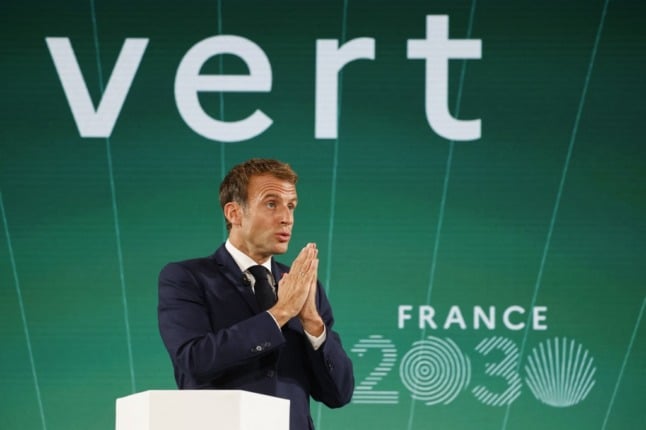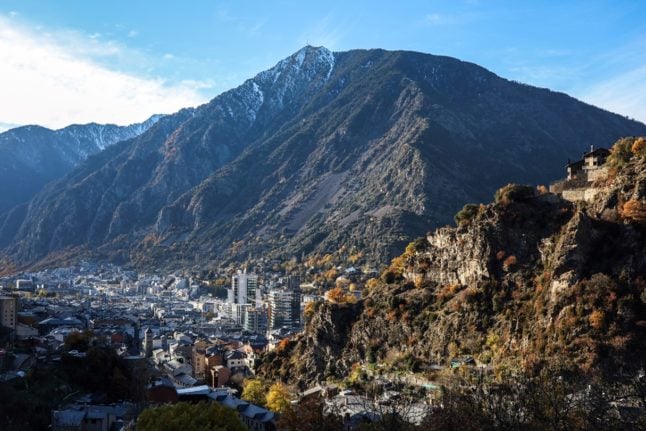Speaking at the Elysee Palace six months before a presidential election and one month ahead of a UN climate summit, Macron said France had taken key decisions “15-20 years later than some of our European neighbours” and now needed to “to become again a nation of innovation and research”.
The spending was to address “a kind of growth deficit” for France brought on by insufficient investment in the past, he told an audience of company leaders and university students.
France, he said, needed to return to “a virtuous cycle” which consisted of “innovating, producing and exporting and in that way finance our social model” as part of a new “France 2030” plan.
Here are the key takeaways from Macron’s announcements.
Green energy
Over the next decade, France would aim to become a global leader in green hydrogen, which companies and governments are increasingly putting at the centre of efforts to de-carbonise economic sectors that rely most on fossil fuels for their energy needs.
Macron singled out steel production, cement and the chemical sector, as well as truck, bus, rail and air transport.
He said that following the Covid-19 pandemic, “which put us face to face with our vulnerabilities”, France had to work towards French and European productive autonomy.
Medical innovation
France also needed to invest heavily in medical research, Macron said.
After the global Covid outbreak, French pharma giants were unable to come up with a vaccine, unlike biotech startups BioNTech and Moderna.
The aim was now for France to develop “at least 20” biotech drugs against cancers, as well as against emerging and chronic illnesses, including those associated with ageing, Macron said.
“We need to concentrate all our efforts on this objective,” he said.
French industry
A French presidential official, who asked not to be named, said Macron had laid out the plan in the wake of the Covid crisis “which showed our vulnerability and our dependence on foreign countries in some key sectors but also the importance of innovation which can change everything.”
French officials believe that France needs to act rapidly to close the gap and not surrender more ground to emerging powers, notably China.
French carmakers, which Macron said had suffered “cruelly” over the past 30 years, should redirect their efforts towards cleaner vehicles, with a target of putting two million electric or hybrid cars on the roads.
Macron said France would also invest €1 billion by 2030 in “disruptive innovation” to produce atomic power, notably by designing small-size nuclear reactors with improved nuclear waste management.
Agriculture of the future
Disruptive innovation was also needed in agriculture, where €2 billion would be earmarked for new technologies, he said, especially in robotics.
France should start “a new revolution” in food production which should be “healthy, sustainable and traceable”.
This would also rely on investment in “three revolutions” which he said were digital, robotics and gene technology.
Agriculture would become cleaner, phase out “some pesticides”, enjoy greater productivity and develop “bio-solutions” that would be “more resilient and more solid”, the president said.
Culture
The France 2030 plan is a framework for economic sovereignty, but also cultural sovereignty. The President said he wanted to “put France in the lead in the production of cultural content”.
Without announcing exact figures, he said the state and the private sector would “invest massively’ in studios, training and content development, to allow France to compete with giants like Amazon and Netflix.
“It’s both a civilisational battle and a battle to create value,” he said, adding that young people should have the option to choose content produced in France and to see French stories being told.
Electronics
Macron also announced “almost €6 billion” of investment to double electronic production in France and to develop smaller chips to remain competitive on the world stage.
The goal is to secure access to semiconductors, the chips which are essential to most of the technology we use today and the shortage of which has slowed production in many industries around the world.
He said France had “lost a significant portion of its autonomy regarding several robotic and digital materials”.
Macron’s plan also called for a boost in French deep sea exploration over the next decade.



 Please whitelist us to continue reading.
Please whitelist us to continue reading.
Where’s the money coming from? Has he been talking to the court jester about how he borrows money with no chance of paying it back.
Funny list isn’t it ? He wants to put money into the old metal bashing industries like steel and at the same time invest in agro gene technology ( which is outlawed in the EU ). Then, it seems to be invest in wherever they’re failing – like medical and vaccine research – without really recognising why they’re failing. He wants to see mini nuclear reactors developed ( no doubt because Rolls Royce is about to clean up in that market ) but France still can’t develop the technology for nuclear powered submarines that will match even half the performance life of UK/US technology. Instead of going for an industrial revolution ( now, where did that start ) maybe he should be looking at marine regeneration, fish stocks and the like.
That Bessemer has got a lot to answer for and as for Watts, well words fail me😄😄. Hargreaves did a good job of keeping my family in the life they were accustomed to and the plantations ticking over nicely.👍👍😊